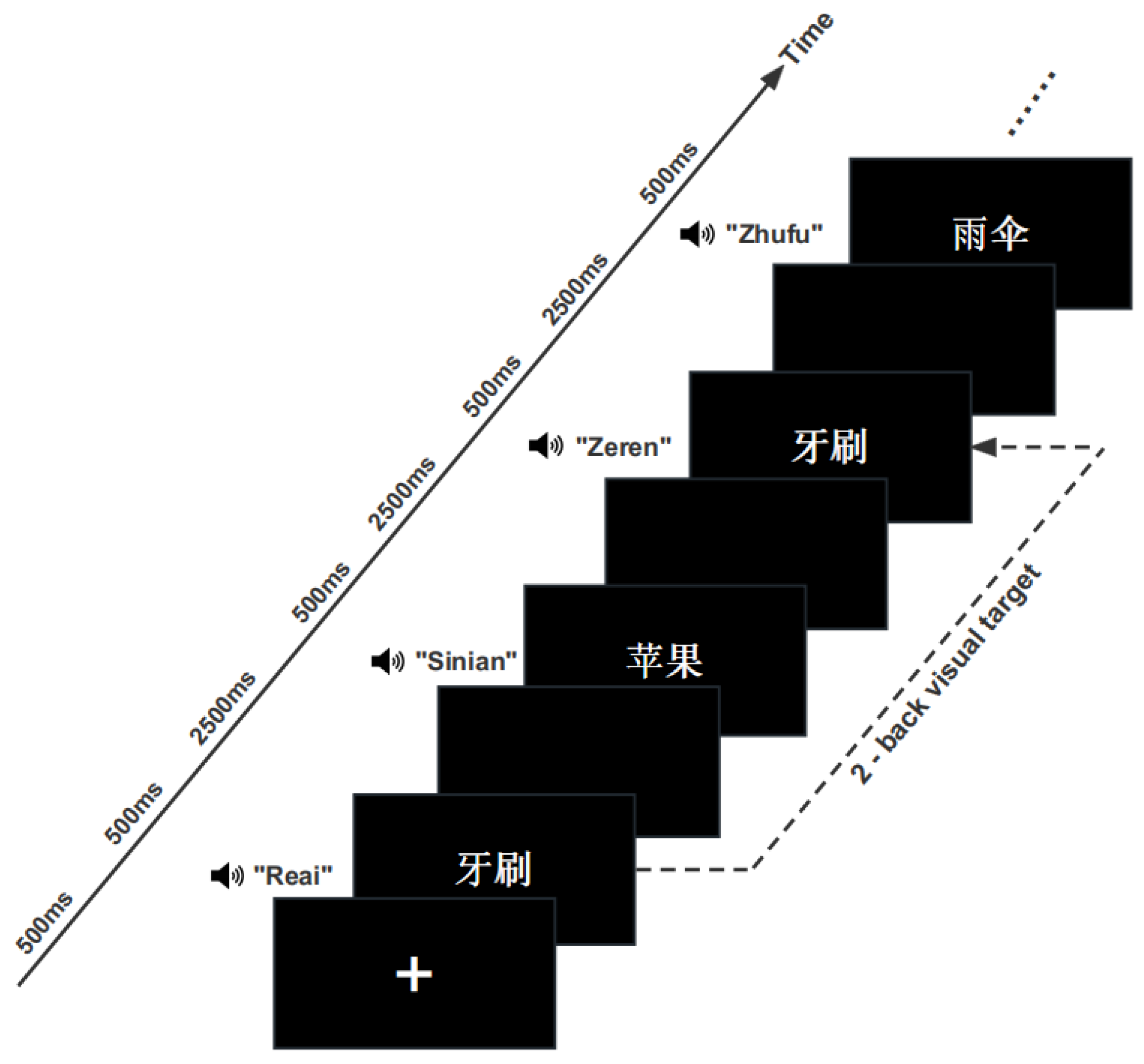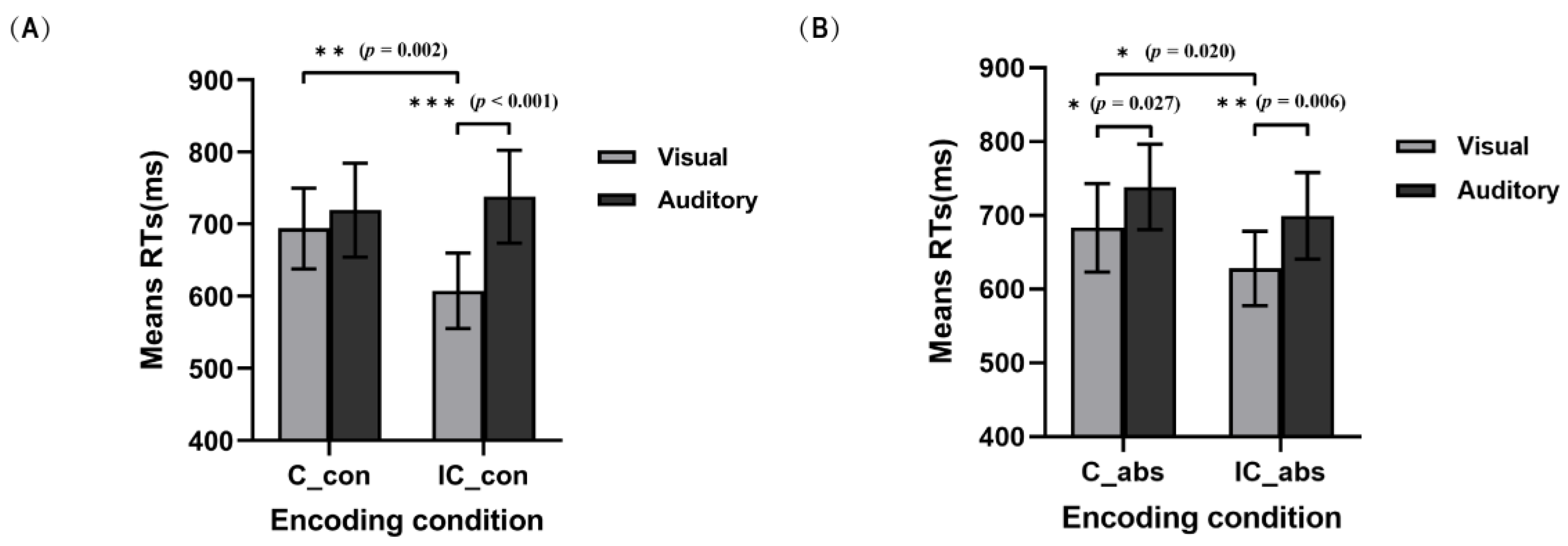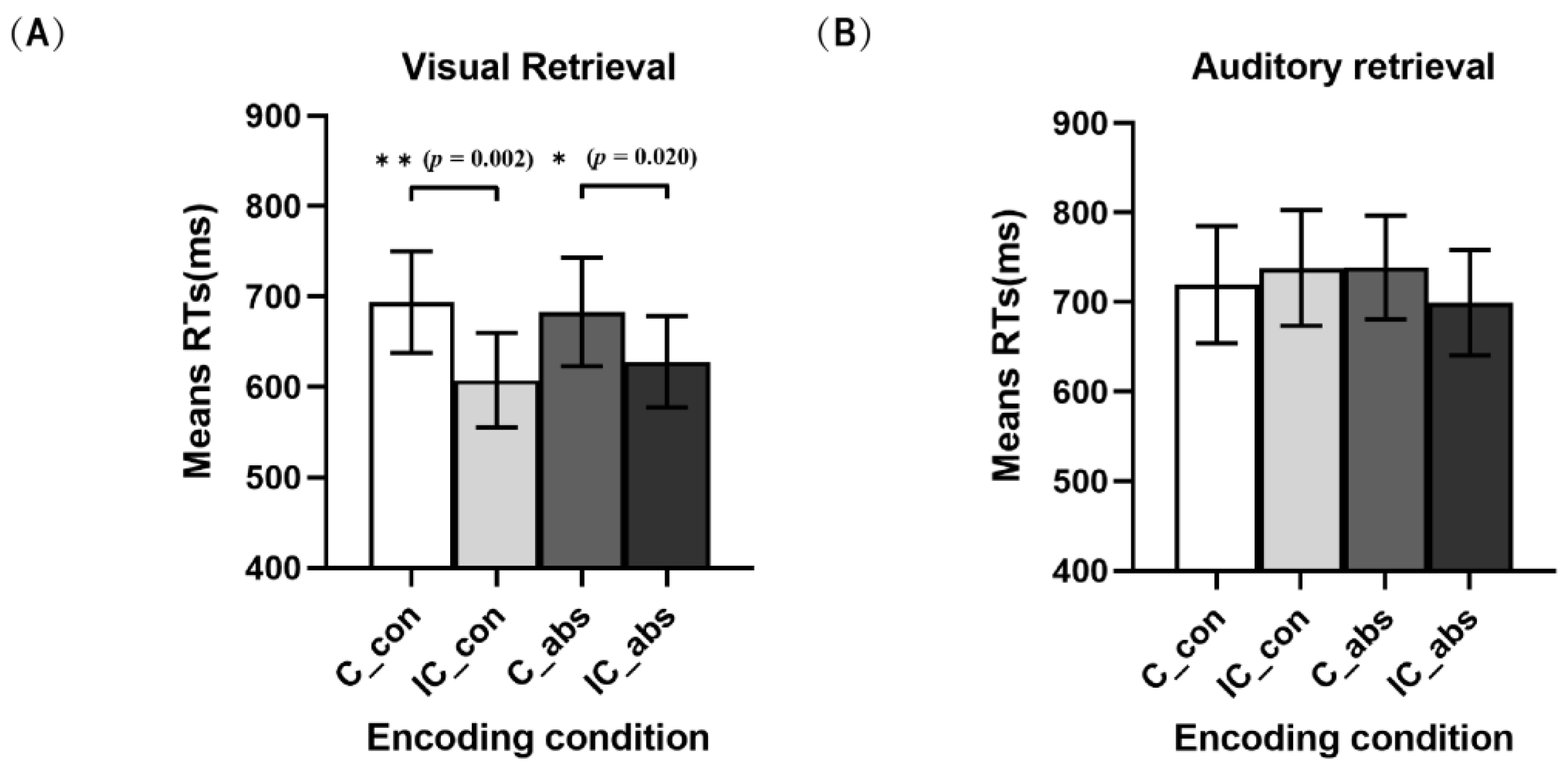Semantic Bimodal Presentation Differentially Slows Working Memory Retrieval
Abstract
:1. Introduction
2. Method
2.1. Participants
2.2. Stimuli and Apparatus
2.2.1. Assessment of the Stimuli Materials
2.2.2. Other Stimuli and Apparatus
2.3. Design and Procedure
3. Results
4. Discussion
4.1. The Multisensory Characteristically (In)congruent Effect
4.2. Words with Different Characteristics in Another Sensory Modality Have Differential Effects on WM Retrieval of Concrete Words and Abstract Words
4.3. Concrete Words and Abstract Words Presented in the Other Sensory Modality Have Different Effects on WM Retrieval of Concrete Words
5. Conclusions
Author Contributions
Funding
Institutional Review Board Statement
Informed Consent Statement
Data Availability Statement
Conflicts of Interest
References
- Baddeley, A. Working memory. Science 1992, 255, 556–559. [Google Scholar] [CrossRef] [PubMed]
- Ivanova, M.V.; Dragoy, O.; Kuptsova, S.V.; Akinina, S.Y.; Petrushevskii, A.G.; Fedina, O.N.; Turken, A.; Shklovsky, V.M.; Dronkers, N.F. Neural mechanisms of two different verbal working memory tasks: A VLSM study. Neuropsychologia 2018, 115, 25–41. [Google Scholar] [CrossRef] [PubMed]
- Yu, H.; Wang, A.; Li, Q.; Liu, Y.; Yang, J.; Takahashi, S.; Ejima, J.; Zhang, M.; Wu, J. Semantically Congruent Bimodal Presentation with Divided-Modality Attention Accelerates Unisensory Working Memory Retrieval. Perception 2021, 50, 917–932. [Google Scholar] [PubMed]
- Abbas Shangari, T.; Falahi, M.; Bakouie, F.; Gharibzadeh, S. Multisensory integration using dynamical Bayesian networks. Front. Comput. Neurosci. 2015, 9, 58. [Google Scholar] [CrossRef]
- Marian, V.; Hayakawa, S.; Schroeder, S.R. Cross-Modal Interaction between Auditory and Visual Input Impacts Memory Retrieval. Front. Neurosci. 2021, 15, 661477. [Google Scholar] [CrossRef]
- Mastroberardino, S.; Santangelo, V.; Botta, F.; Marucci, F.S.; Belardinelli, M.O. How the bimodal format of presentation affects working memory: An overview. Cogn. Process. 2008, 9, 69–76. [Google Scholar] [CrossRef]
- Brunetti, R.; Indraccolo, A.; Mastroberardino, S.; Spence, C.; Santangelo, V. The impact of cross-modal correspondences on working memory performance. J. Exp. Psychol. Hum. Percept. Perform. 2017, 43, 819–831. [Google Scholar] [CrossRef]
- Xie, Y.; Li, Y.; Xie, B.; Xu, Y.; Peng, L. The neural basis of complex audiovisual objects maintenances in working memory. Neuropsychologia 2019, 133, 107189. [Google Scholar] [CrossRef]
- Doehrmann, O.; Naumer, M.J. Semantics and the multisensory brain: How meaning modulates processes of audio-visual integration. Brain Res. 2008, 1242, 136–150. [Google Scholar] [CrossRef]
- Xie, Y.; Xu, Y.; Bian, C.; Li, M. Semantic congruent audiovisual integration during the encoding stage of working memory: An ERP and sLORETA study. Sci. Rep. 2017, 7, 5112. [Google Scholar] [CrossRef]
- Lorenc, E.S.; Mallett, R.; Lewis-Peacock, J.A. Distraction in Visual Working Memory: Resistance is Not Futile. Trends Cogn. Sci. 2021, 25, 228–239. [Google Scholar] [CrossRef] [PubMed]
- Duarte, S.E.; Ghetti, S.; Geng, J.J. Object memory is multisensory: Task-irrelevant sounds improve recollection. Psychon. Bull. Rev. 2022, 30, 652–665. [Google Scholar] [CrossRef] [PubMed]
- Li, Q.; Yu, Y.; Liu, Y.; Xu, Z.; Fan, L.; Takahashi, S.; Yang, J.; Ejima, Y.; Wu, Q.; Wu, J. Whether attentional loads influence audiovisual integration depends on semantic associations. Atten. Percept. Psychophys. 2022, 84, 2205–2218. [Google Scholar] [CrossRef] [PubMed]
- Heikkilä, J.; Alho, K.; Tiippana, K. Semantically congruent visual stimuli can improve auditory memory. Multisens. Res. 2017, 30, 639–651. [Google Scholar] [CrossRef]
- Heikkilä, J. Benefits of Audiovisual Memory Encoding across the Life Span. Doctoral Dissertation, University of Helsinki, Helsinki, Finland, 2018. [Google Scholar]
- Montefinese, M. Semantic representation of abstract and concrete words: A minireview of neural evidence. J. Neurophysiol. 2019, 121, 1585–1587. [Google Scholar] [CrossRef]
- Bucur, M.; Papagno, C. An ALE meta-analytical review of the neural correlates of abstract and concrete words. Sci. Rep. 2021, 11, 15727. [Google Scholar] [CrossRef]
- Perry, C.; Willison, A.T.; Walker, M.K.; Nankivell, M.C.; Lawrence, L.M.; Thomas, A. Working memory load affects early affective responses to concrete and abstract words differently: Evidence from ERPs. Cogn. Affect. Behav. Neurosci. 2019, 19, 377–391. [Google Scholar] [CrossRef]
- Oberauer, K. When does working memory get better with longer time? J. Exp. Psychol. Learn. Mem. Cogn. 2022, 48, 1754. [Google Scholar] [CrossRef]
- Paivio, A. Dual coding theory: Retrospect and current status. Can. J. Psychiat. Rev. Can. Psychiat. 1991, 45, 255–287. [Google Scholar] [CrossRef]
- Schwanenflugel, P.J. Why are abstract concepts hard to understand? In The Psychology of Word Meanings; Psychology Press: London, UK, 2013; pp. 235–262. [Google Scholar]
- Reilly, M.; Desai, R.H. Effects of semantic neighborhood density in abstract and concrete words. Cognition 2017, 169, 46–53. [Google Scholar] [CrossRef]
- Zhang, X.; Han, Z.; Bi, Y. Are abstract and concrete concepts organized differently? Evidence from the blocked translation paradigm. Appl. Psycholinguist. 2013, 34, 1059–1092. [Google Scholar] [CrossRef]
- Soveri, A.; Antfolk, J.; Karlsson, L.; Salo, B.; Laine, M. Working memory training revisited: A multi-level meta-analysis of n-back training studies. Psychon. Bull. Rev. 2017, 24, 1077–1096. [Google Scholar] [CrossRef] [PubMed]
- Yang, W.; Li, S.; Xu, J.; Li, Z.; Yang, X.; Ren, Y. Selective and divided attention modulates audiovisual integration in adolescents. Cogn. Dev. 2020, 55, 100922. [Google Scholar] [CrossRef]
- Wang, J.; Conder, J.A.; Blitzer, D.N.; Shinkareva, S.V. Neural representation of abstract and concrete concepts: A meta-analysis of neuroimaging studies. Hum. Brain Mapp. 2010, 31, 1459–1468. [Google Scholar] [CrossRef] [PubMed]
- Faul, F.; Erdfelder, E.; Lang, A.G.; Buchner, A. G*Power 3: A flexible statistical power analysis program for the social, behavioral, and biomedical sciences. Behav. Res. Methods 2007, 39, 175–191. [Google Scholar] [CrossRef]
- Villani, C.; Orsoni, M.; Lugli, L.; Benassi, M.; Borghi, A.M. Abstract and concrete concepts in conversation. Sci. Rep. 2022, 12, 17572. [Google Scholar] [CrossRef] [PubMed]
- Wang, X.; Wu, W.; Ling, Z.; Xu, Y.; Fang, Y.; Wang, X.; Binder, J.; Men, W.; Gao, J.; Bi, Y. Organizational principles of abstract words in the human brain. Cereb. Cortex 2018, 28, 4305–4318. [Google Scholar] [CrossRef]
- Ratcliff, R. Methods for dealing with reaction time outliers. Psychol. Bull. 1993, 114, 510–532. [Google Scholar] [CrossRef]
- Malinovitch, T.; Jakoby, H.; Ahissar, M. Training-induced improvement in working memory tasks results from switching to efficient strategies. Psychon. Bull. Rev. 2021, 28, 526–536. [Google Scholar] [CrossRef]
- Baddeley, A.D. Working Memory; Clarendon Press/Oxford University Press: New York, NY, USA, 1986. [Google Scholar]
- Yu, H.; Wang, A.; Zhang, M.; Yang, J.; Takahashi, S.; Ejima, Y.; Wu, J. Semantically congruent audiovisual integration with modal-based attention accelerates auditory short-term memory retrieval. Atten. Percept. Psychophys. 2022, 84, 1625–1634. [Google Scholar] [CrossRef]
- Zhong, Y.; Huang, C.R.; Ahrens, K. Embodied grounding of concreteness/abstractness: A sensory-perceptual account of concrete and abstract concepts in Mandarin Chinese. In Chinese Lexical Semantics: 22nd Workshop, CLSW 2021, Nanjing, China, 15–16 May 2021, Revised Selected Papers, Part II; Springer International Publishing: Cham, Switzerland, 2022; pp. 72–83. [Google Scholar]
- Gao, Z.; Wu, F.; Qiu, F.; He, K.; Yang, Y.; Shen, M. Bindings in working memory: The role of object-based attention. Atten. Percept. Psychophys. 2017, 79, 533–552. [Google Scholar] [CrossRef]
- Santangelo, V.; Macaluso, E. The contribution of working memory to divided attention. Hum. Brain Mapp. 2013, 34, 158–175. [Google Scholar] [CrossRef] [PubMed]
- Dimakopoulos, V.; Mégevand, P.; Stieglitz, L.H.; Imbach, L.; Sarnthein, J. Information flows from hippocampus to auditory cortex during replay of verbal working memory items. eLife 2022, 11, e78677. [Google Scholar] [CrossRef] [PubMed]
- Christophel, T.B.; Klink, P.C.; Spitzer, B.; Roelfsema, P.R.; Haynes, J.D. The distributed nature of working memory. Trends Cogn. Sci. 2017, 21, 111–124. [Google Scholar] [CrossRef] [PubMed]
- Acheson, D.J.; MacDonald, M.C. Verbal working memory and language production: Common approaches to the serial ordering of verbal information. Psychol. Bull. 2009, 135, 50–68. [Google Scholar] [CrossRef]
- Jefferies, E.; Patterson, K.; Jones, R.W.; Lambon Ralph, M.A. Comprehension of concrete and abstract words in semantic dementia. Neuropsychology 2009, 23, 492–499. [Google Scholar] [CrossRef]
- Hoffman, P.; Binney, R.J.; Lambon Ralph, M.A. Differing contributions of inferior prefrontal and anterior temporal cortex to concrete and abstract conceptual knowledge. Cortex 2015, 63, 250–266. [Google Scholar] [CrossRef]
- Davis, C.P.; Altmann, G.T.; Yee, E. Situational systematicity: A role for schema in understanding the differences between abstract and concrete concepts. Cogn. Neuropsychol. 2020, 37, 142–153. [Google Scholar] [CrossRef]
- Peng, Y.; Liu, Y.; Guo, C. Examining the neural mechanism behind testing effect with concrete and abstract words. Neuroreport 2019, 30, 113–119. [Google Scholar] [CrossRef]
- Kousta, S.T.; Vigliocco, G.; Vinson, D.P.; Andrews, M.; Del Campo, E. The representation of abstract words: Why emotion matters. J. Exp. Psychol. Gen. 2011, 140, 14–34. [Google Scholar] [CrossRef]
- Estes, Z.; Verges, M.; Adelman, J.S. Words, objects, and locations: Perceptual matching explains spatial interference and facilitation. J. Mem. Lang. 2015, 84, 167–189. [Google Scholar] [CrossRef]
- Schmid, C.; Buchel, C.; Rose, M. The neural basis of visual dominance in the context of audio-visual object processing. Neuroimage 2011, 55, 304–311. [Google Scholar] [CrossRef]
- Bizley, J.K.; Cohen, Y.E. The what, where and how of auditory-object perception. Nat. Rev. Neurosci. 2013, 14, 693–707. [Google Scholar] [CrossRef] [PubMed]
- Xiao, X.; Zhao, D.; Zhang, Q.; Guo, C.Y. Retrieval of concrete words involves more contextual information than abstract words: Multiple components for the concreteness effect. Brain Lang. 2012, 120, 251–258. [Google Scholar] [CrossRef]
- Wang, X.; Wang, B.; Bi, Y. Close yet independent: Dissociation of social from valence and abstract semantic dimensions in the left anterior temporal lobe. Hum. Brain Mapp. 2019, 40, 4759–4776. [Google Scholar] [CrossRef]
- Borghi, A.M. Concepts for which we need others more: The case of abstract concepts. Curr. Dir. Psychol. 2022, 31, 238–246. [Google Scholar] [CrossRef]
- Crutch, S.J.; Connell, S.; Warrington, E.K. The different representational frameworks underpinning abstract and concrete knowledge: Evidence from odd-one-out judgements. Q. J. Exp. Psychol. 2009, 62, 1377–1390. [Google Scholar] [CrossRef]
- Paivio, A. Dual coding theory and the mental lexicon. Ment. Lex. 2010, 5, 205–230. [Google Scholar] [CrossRef]
- Besser, J.; Koelewijn, T.; Zekveld, A.A.; Kramer, S.E.; Festen, J.M. How linguistic closure and verbal working memory relate to speech recognition in noise—A review. Trends Amplif. 2013, 17, 75–983. [Google Scholar] [CrossRef]
- Zimmer, H.D.; Fischer, B. Visual working memory of Chinese characters and expertise: The expert’s memory advantage is based on long-term knowledge of visual word forms. Front. Psychol. 2020, 11, 516. [Google Scholar] [CrossRef]
- Cohen, M.A.; Evans, K.K.; Horowitz, T.S.; Wolfe, J.M. Auditory and visual memory in musicians and nonmusicians. Psychon. Bull. Rev. 2011, 18, 586–591. [Google Scholar] [CrossRef] [PubMed]




| Set | Concrete Words | Abstract Words | ||
|---|---|---|---|---|
| 1 | 牙刷 | toothbrush | 自由 | freedom |
| 2 | 书本 | book | 公平 | fairness |
| 3 | 剪刀 | scissor | 原理 | principle |
| 4 | 衣服 | clothes | 思念 | yearning |
| 5 | 眼镜 | glasses | 热爱 | enthusiasm |
| 6 | 电脑 | computer | 鼓励 | encouragement |
| 7 | 雨伞 | umbrella | 精神 | spirit |
| 8 | 苹果 | apple | 名声 | reputation |
| 9 | 花朵 | flower | 祝福 | blessing |
| 10 | 香蕉 | banana | 隐私 | privacy |
| 11 | 书桌 | desk | 成功 | success |
| 12 | 时钟 | clock | 希望 | hope |
| 13 | 手机 | mobile phone | 责任 | responsibility |
| 14 | 西瓜 | watermelon | 记忆 | memory |
| 15 | 杯子 | glass | 幸福 | happiness |
| 16 | 篮球 | basketball | 坚强 | fortitude |
| 17 | 猫咪 | cat | 魅力 | charm |
| 18 | 电灯 | electric light | 梦想 | dream |
| 19 | 毛巾 | towel | 民主 | democracy |
| 20 | 浴缸 | bathtub | 和谐 | harmony |
| 21 | 石头 | stone | 友善 | kindness |
| 22 | 哑铃 | dumbbell | 文明 | civilization |
| 23 | 鞋子 | shoes | 正直 | integrity |
| 24 | 书包 | schoolbag | 敬业 | dedication |
| Characteristic | Familiarity (Means ± SDs) | Concreteness (Means ± SDs) | Emotional Arousal (Means ± SDs) |
|---|---|---|---|
| Concrete | 3.73 ± 0.21 | 4.13 ± 0.10 | 3.41 ± 0.24 |
| Abstract | 3.82 ± 0.10 | 3.34 ± 0.10 | 3.71 ± 0.19 |
Disclaimer/Publisher’s Note: The statements, opinions and data contained in all publications are solely those of the individual author(s) and contributor(s) and not of MDPI and/or the editor(s). MDPI and/or the editor(s) disclaim responsibility for any injury to people or property resulting from any ideas, methods, instructions or products referred to in the content. |
© 2023 by the authors. Licensee MDPI, Basel, Switzerland. This article is an open access article distributed under the terms and conditions of the Creative Commons Attribution (CC BY) license (https://creativecommons.org/licenses/by/4.0/).
Share and Cite
Cheng, J.; Li, J.; Wang, A.; Zhang, M. Semantic Bimodal Presentation Differentially Slows Working Memory Retrieval. Brain Sci. 2023, 13, 811. https://doi.org/10.3390/brainsci13050811
Cheng J, Li J, Wang A, Zhang M. Semantic Bimodal Presentation Differentially Slows Working Memory Retrieval. Brain Sciences. 2023; 13(5):811. https://doi.org/10.3390/brainsci13050811
Chicago/Turabian StyleCheng, Jia, Jingjing Li, Aijun Wang, and Ming Zhang. 2023. "Semantic Bimodal Presentation Differentially Slows Working Memory Retrieval" Brain Sciences 13, no. 5: 811. https://doi.org/10.3390/brainsci13050811
APA StyleCheng, J., Li, J., Wang, A., & Zhang, M. (2023). Semantic Bimodal Presentation Differentially Slows Working Memory Retrieval. Brain Sciences, 13(5), 811. https://doi.org/10.3390/brainsci13050811






